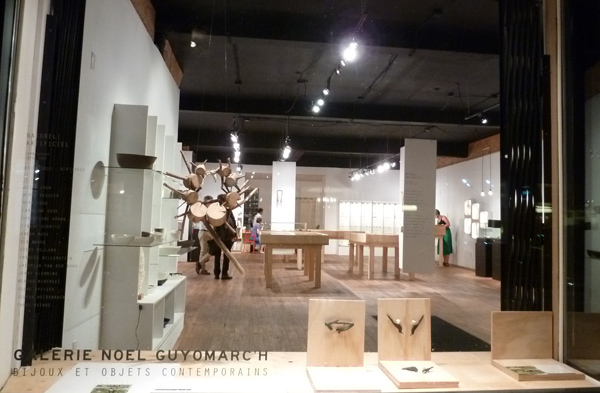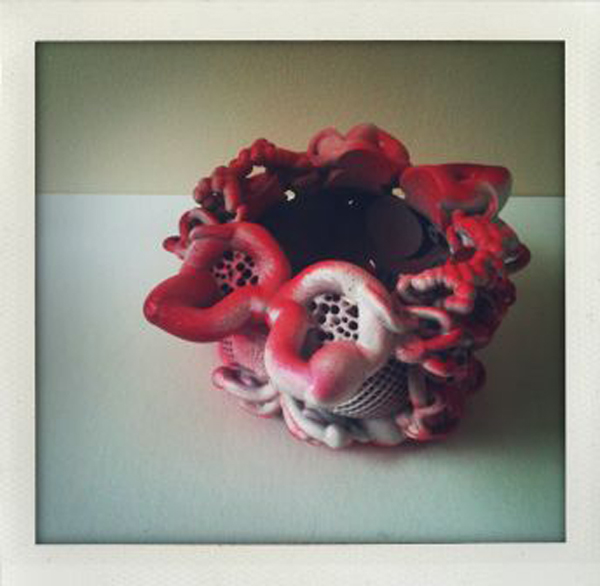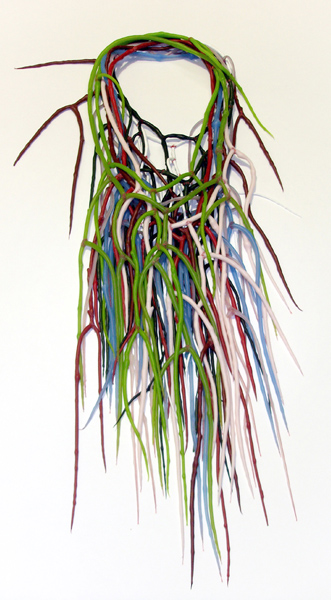
Susan Cummins: Noel, in the May AJF newsletter you talked about your recent move to a larger space. Congratulations! You have been in the business for sixteen years and I am wondering if you can tell me how the contemporary jewelry field has changed during that time.
Noel Guymarc’h: From the beginning, my goal was to promote Canadian contemporary jewelry with temporary international exhibitions. Unfortunately, there were not so many Canadian artists. I decided to invite international artists for permanent representation. But in the past ten years, as I mentioned in the newsletter, there has been a change and I really feel confident about the new generation. At the same time, running a gallery is not always easy. Education, passion, awareness and persistence are the reasons of the gallery’s presence. And to be in business for sixteen years gives credibility, too, without compromises in the selection of work.

Noel Guyomarc’h: I am originally from France where I studied economics and worked for few years in administration before moving to Canada 25 years ago. It was by chance that I ended up in this field. During my first trip in Montreal, I met a jewelry designer. Six months later, I came back to live as a resident. She introduced me to the owner of a jewelry shop-gallery who hired me. I stayed six years. During that period I became familiar with the local and international jewelry field by acquiring specialized books and magazines and I took some jewelry classes.
Is the show Natural/ Artificial an unusual one for you? Do you often present shows curated by artists or others?
Noel Guyomarc’h: No, this exhibition is not unusual for me. I try at least once a year to have such exhibition, with or without a specific theme. It can be a collective exhibition to introduce trends from a specific country (Finland, France, Spain, The Netherlands, to name a few) or a new generation of artists. In 2010 I had an exhibition on glass jewelry with many internationals such as Karl Fritsch, Donald Friedlich, Carolina Martinez Linares and Joan Parcher.

Noel Guyomarc’h: I have worked with Luzia for twelve years and have appreciated her work for long time now. In 2006 I suggested the idea of a duo exhibition, where she could choose the other artist. She invited Natalie Luder, a Swiss artist I didn’t know and her work was amazing. In 2010 Luzia and I met at Schmuck in Munich. She introduced me to many artists and we had long conversations about jewelry. A few months later, I asked her to curate an exhibition for my gallery. I am really pleased with her choices and her views. This is her first experience as a curator.
Luzia, you are known for making combs into brooches and coins into bowls. Please give me a brief description of your background to explain how you got there.
Luzia Vogt: I am fond of and attracted by found objects. At one point I wanted to become an archaeologist, but my interest turned out to be stronger on the things I create myself. I am interested in habits, everyday objects and so called ‘objects and materials which are considered as not valuable anymore.’ I am curious how I react and what I invent.
Who are your artistic heroes?
Luzia Vogt: I do not like the expression hero. Hero is exaggerated in my eyes. But I do admire different people. For instance people who follow their own way, no matter what.
In Natural/Artificial you seem to be dealing with two subjects at the same time. One is about recycling found objects made of plastic, rubber or man-made materials and the other is about nature as a subject for jewelry. Can you explain how these two topics merge in this show?

In this group of artists, none is working with recycling objects. The purpose or intention is the use of manufactured or industrial products such as plastic toys, artificial flowers, silicone or the use of new technology such as CAD cam. Mikiko Minewaki buys new plastic toys which she transforms into imagined flowers. Tanel Veenre combines pins or pendants of carved stones, insects and other animals cast in resin, giving the impression of amber collecting natural elements during its formation. He subsequently cuts this material into geometric shapes. Silvia Weidenbach creates on the computer invented forms and she incorporates parts of true images. She combines and multiplies them and then uses a 3D printing system to produce the work. Christiane Köhne buys artificial flowers in various materials and glues them in layers to get a sheet she cuts into geometric shapes. Playing with the shades of color, she sometimes adds plastic stems on which flowers were set to offer a contrasted texture and volume.
Some of the artists in the exhibition are working with artificial materials and some are working with natural materials, mainly wood. In your view do they come to similar statements about nature? Or artificiality?
Luzia Vogt: As curator, my selection had to offer a range of work and statements. The intention of each artist was not automatically related to the theme, but my consideration as curator saw the link between their works. Moreover many of the selected pieces are not new but always respond to my choice. The necklace Roots, made of silicone, pigments and thread by Ela Bauer was made in 2008,; Beech Twig, the neckpiece by Jacomijn van der Donk in 2007; and Guirlande by Evert Nijland in 2005.

Luzia Vogt: No, I am interested how other people treat this subject, especially in different and other approaches to mine. Occasionally I use found objects in my work but none of the other participants do.
You also say, ‘Today, what are the limits of the natural and the artificial? Do these limits exist? The purpose of this exhibition is to display work that deals with the natural and the artificial in relation with our natural – or perhaps no longer so natural – bodies.’ Can you expand on this statement a bit? What do you see as the limits of the natural and artificial? Why are our bodies no longer natural?
Luzia Vogt: When I talk about the artificiality of our bodies, I think of cosmetic surgery, breast implants, dental devices, genetic manipulation . . . More and more, we are looking for perfection without leaving a space for the natural or freedom. We need to control our environment and our lifestyle choices we believe as unique but the society and the culture manipulate us. Even nature suffers this control. Our gardens, our parks, our forests are the result. Can we keep seeing nature the way it should be?
You seem to have a broad range of interests. Have you curated any shows before this one? If so what were the themes?
Luzia Vogt: This is my first experience as curator. Noel gave me carte blanche and I did enjoy it. I didn’t know all of the participating artists. It was nice that they accepted my invitation. It was a pleasant process. In 2006, I had a proposal from Noel to invite an artist he didn’t know to have a duo exhibition in his gallery. I chose Natalie Luder, a Swiss artist I met in a show in Scotland few months before Noel’s proposal.
Have you seen any special exhibitions lately you feel were extraordinary?
Luzia Vogt: Recently, the quite small show of sketches and photographs of work from the designers Ronan and Erwan Bouroullec at the Vitra Design Museum.






